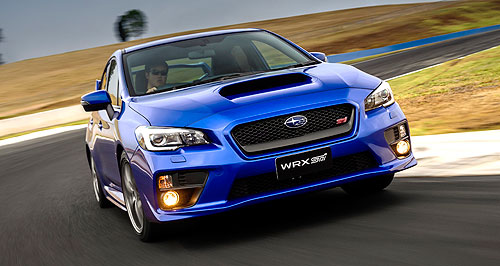Driven: Subaru’s new WRX STI slashed to $49,990
BY DANIEL GARDNER | 16th Apr 2014

Arriving just a few weeks after its WRX sibling, the new-look STI packs the same ‘EJ25’ engine as before, but benefits from a number of refinements under the skin to the suspension, gearbox and cabin design.
New to the range also is a ‘luxurious’ STI Premium version, which replaces the old $65,990 Spec R at the top of the tree. At $54,990, this version is a massive $11,000 cheaper than its predecessor.
These price cuts to Subaru’s performance icon echo those it applied to the new-generation WRX when it launched last month. At $38,990, that vehicle carries a lower sticker price than the original model when it launched in 1994.
The STI’s sharper pricing is evidently expected to give the car broader appeal than before, with Subaru Australia increasing its network of STI specialist dealers from 12 to 20 nationally. There are an additional 17 STI test drive centres in mainly rural areas.
Intriguingly, customers will be able order the STI online and take delivery from one of these STI dealers or test drive centres. This sales model is similar to the one Subaru pioneered with the BRZ coupe, which was heavily supply-restricted at launch.
Aimed directly at high-performance enthusiasts, the new STI is now available only with a six-speed manual gearbox. Of course, being a Subaru, power is sent to all four wheels via an “always on” system featuring a Viscous LSD.
Under the bonnet of both is a carried-over turbocharged 2.5-litre horizontally-opposed Boxer four-cylinder engine producing 221kW at 6000rpm and 407Nm at 4000rpm.
The claimed zero to 100km/h sprint time is 4.9 seconds, the same as before.
Fuel consumption is a claimed 10.4L/100km on 98 RON petrol, down 0.1L/100km.
The substantial and iconic boot spoiler, which, in a range-first can be deleted for no cost, and deep bucket seats will win approval from Subaru aficionados.
The cabin is said to be more upmarket, with extra soft-touch plastics on contact points.
Subaru's symmetrical all-wheel drive system is coupled to a multi-mode Driver Control Centre Differential (DCCD) and controlled by an active torque vectoring system. The system allows the very best use of torque when close to the limits of traction.
In Traction mode, high-speed surfaced road performance is optimised by altering VDC settings for spending time on racing circuits, while VDC off mode is used for negotiating very slippery surfaces such as snow and mud.
As with previous versions, the STI suspension (front MacPherson strut and rear double wishbones) represents the more aggressive end of the road car range, picking up from the standard WRX and adding more high-performance features.
At the front-end, virtually every element of the suspension set-up has been modified, with stiffened cross-members, bushings stabiliser bars, mount-points, with uprated struts, spring rates and lower control-arms resulting in a 14 per cent lateral stiffness increase.
It is a similar story at the other end with many of the front-end measures repeated but with a lowered sub-frame and repositioned mountings boosting lateral stiffness by 35 per cent.
The steering remains a hydraulic power-assisted system for a more natural road feel, and the steering ratio is a quick 13.0:1. Subaru claims to have the same steering response (the delay between input and response) as the new Porsche 911.
Picking gear ratios is left entirely up to the driver with a short-throw gear-lever connected to revised and vibration-reduced six-speed manual gearbox.
Differential settings are controlled with a centre console-mounted dial.
More high-tensile steel is used in the construction, improving rigidity and refinement despite the stiffer suspension.
The redesigned body sits on 18-inch wheels (with a space-saver spare) on Dunlop SP Sport MAXX 245/40 R18 tyres, while the Premium gets lightweight BBS rims.
The unique mesh grille and badges remain, though new to the range are LED headlights with daytime running lights below.
Like the Rex, the base of the A-pillar has been shifted forward by 200mm to improve mid-corner visibility. The large floor undercover is lowered 15mm to improve aerodynamics and fuel economy.
Inside the higher-class cabin – replete with a smaller, D-shaped steering wheel, push-button start, twin screens for audio and driving information (4.5-inch and 3.5-inch respectively) and leather/Alcantara bucket seats – there is also more room for passengers.
The wheelbase is increased by 25mm to 2650mm, adding rear leg room. The cabin is also 15mm wider, for better elbow and shoulder room, without changing total body width.
Cargo capacity is significantly improved from the superseded sedan, up 40 litres to 460L, and the rear seats flip down 60:40.
Standard in the revised STI fascia is a harmon kardon sound-system, satellite-navigation, USB and Bluetooth capability, the aforementioned twin screens, a new shark fin antenna and a lairy body kit.
For an extra $5000 over and above the base STI, the Premium variant adds lightweight BBS 18-inch wheels, an electric sunroof, heated front seats, heated door mirrors, leather trim (rather than partial leather/Alcantara), a powered driver’s seat and a wiper de-icer.
The new STI attained an ANCAP test score of 35.85 out of 37 – a five-star result – while a new driver’s knee-bag takes the total airbag count to seven.
Subaru WRX STI pricing:*
STI $49,990
STI Premium $54,990
* Plus on-road costs